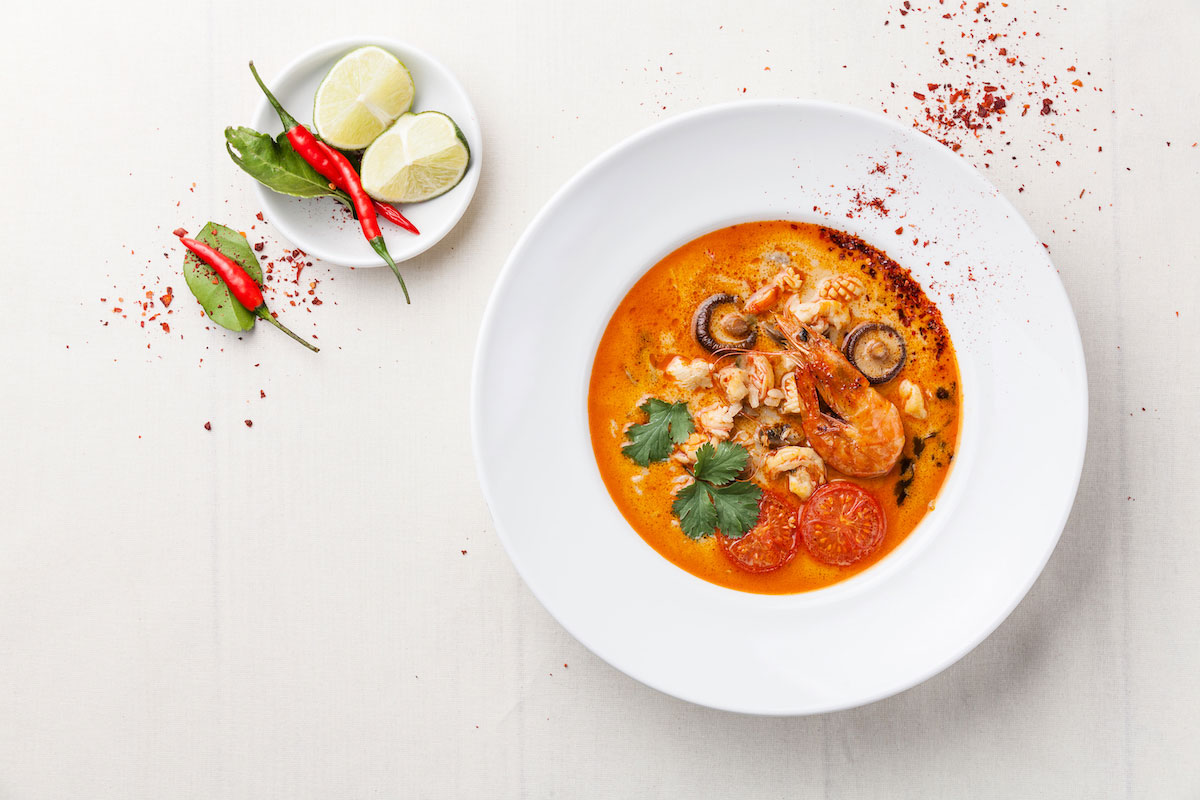Sweet, sour, salty, and undoubtedly spicy. The spice in Thai food is one of four magical elements that combine to create a cuisine that is beloved around the world. To understand Thailand’s love of spicy food is to appreciate some of the best dishes in the world and tantalize your taste buds with zinging, tangy, hot flavors. The great news is that not only do these hot classics taste delicious but they are feel-good foods that inspire wellness benefits too.
Of course, if your delicate constitution cannot handle spicy, fear not, there are plenty of Thai foods you can enjoy without having to cool down with iced water.
Classic Thai Flavors
The spicy flavors within Thai recipes are integral to creating perfectly balanced dishes. Whilst many restaurants cool-down the heat for tourists, the true way to appreciate Thai food is to let the heat work its magic. Many Thais judge a dish by its finely balanced spices, and the general rule is, the spicier, the better.
As well as chilis, ginger ups the heat factor and is often used in soups; eaten raw with white cabbage and barbequed sausages; or as a sauce with velvety Hainanese chicken and oily rice, with pickled ginger on the side for good measure.
Garlic is an absolute staple in Thai cooking. And you can forget the European style of adding a clove or two. Think instead of a handful of small cloves bashed in a pestle and mortar and thrown in stir-fry dishes with abandon. Fried garlic generously tops piping-hot grilled chicken. And together with Thai Basil, is one of the main flavors in Thailand’s signature stir-fry, ‘pad kra pow’. This dish is a favorite for breakfast to set you up for the day, often served with a fried egg and chili-laden fish sauce.
Peppercorns are another heat-inducing staple and recipes don’t hold back on adding whole branches into some dishes. A popular classic is sweet green curry where many green peppercorns are added whole into the sauce.
If one ingredient is associated with Thai food, then it’s without doubt the chili pepper. In Thai cookery, there are many different chilis from sweet peppers to spur chili, serrano chili, karen chili, and the world-renowned bird’s eye chili which are small but extremely potent. While chili peppers found their way to Thailand from South America, via European traders, they are an intrinsic part of many authentic Thai dishes from curries to soups and stir-fries.
The spiciness of Thai dishes ranges from a deep heat that rises in a great southern curry to the intense burst of heat from a citrusy Thai meat salad, called ‘laab’ or a ‘som tam’ green mango salad. Soups from the rural east, Issan, can also have you sweating heavily and reaching for a cold drink within seconds. To really understand Thai food is to appreciate the sudden sting to your lips as the spice hits you.
The Health Benefits of Spicy Food
If the idea of eating hot food in a hot country seems counter-intuitive, it isn’t. Adding some spice into your diet in the tropics is actually really good for you. The spices get your circulation moving, and this helps to regulate your sweat and actually cools you down over time. On a practical level, spices keep food fresher for longer too, and the anti-bacterial properties preserve meat and also reduce not-so-friendly bacteria in the body too. It isn’t a coincidence that many hot countries favor an equally heat-inducing cuisine.
Heat is good for your heart too, and there is a lower incidence of heart attacks and strokes in countries with a spicy diet. Chilis combat the effects of bad cholesterol, and they are also anti-inflammatory. Other health benefits of chilis include active ingredients that clear the respiratory system from congestion, as well as the sinuses. At the same time, there is evidence that chili peppers could help reduce blood pressure.
Aside from chilis, other hot ingredients have their own wellness properties. Ginger is regarded as a powerful antioxidant and anti-inflammatory. As well as aiding better digestion, ginger is purported to relieve soreness in muscles and act as a pain-reliever, while also helping with an upset stomach and indigestion. Research into the effects of ginger on lowering bad cholesterol and blood sugar levels as well as protecting the heart is ongoing.
Black peppercorns aid digestion and bring on perspiration which, in turn, cools the body. Garlic, on the other hand, is renowned for having many wellbeing properties. It is widely believed that garlic can combat high cholesterol and high blood pressure as well as improve the circulation. Garlic is highly nutritious too, containing manganese, vitamin B6, vitamin C, and selenium, not to mention an antioxidant and an immune-system booster.
Avoiding Spicy Thai Food
If your palate simply won’t embrace the heat, there are plenty of ways you can still enjoy the complex flavors of Thai food without too much spice. The same dish can be fairly mild in one restaurant and steam-coming-out-your-ears hot in another, so the rule of thumb is that it’s always best to be clear about your spice-tolerance as you order. “Mai ou pet” means, “I don’t want my dish spicy at all,” whereas, “Ou pet nid noi” lets your server know you want a little heat but not too much.
On the other hand, you may want to make sure that a dish is authentically hot or extra-spicy by asking for your meal to be “pet maak.” There are also many appetizing options if you don’t like eye-watering heat when you eat. Clear soups are perfect as you can add your own sugar and spice to suit their personal preferences. Another dish that can be spiced up or not is ‘rad na,’ thick gravy with either meat or seafood and wide, flat rice noodles. A classic ‘pad thai’ with fried bean sprouts, noodles, tofu, and more is refreshingly tasty, whilst barbequed meats such as chicken are often served with a sweet chili dip, and grilled seafood skewers often come served with a choice of spicy or sweet sauce too. Fried rice may have a sprinkling of white pepper, but aside from this, serves-up a deliciously moreish dish that is perfect in the morning.
Thailand’s Top Spicy Dishes
If heat hits the spot, then you’ll appreciate that with the pain comes some pleasure too, as the spices send messages to release feel-good neurotransmitters, endorphins, and dopamine. Just as chocolate physiologically makes you feel happier, so too can a good spicy Thai dish.
With a milky Thai tea in hand to cut through the heat, a glass of water, a napkin, and preferably a fan for al fresco dining or an air-conditioned restaurant, you are ready to sample some signature spicy specials. Try ‘sen yai pad kee mao gung,’ drunken noodles with prawns. Flat, fettuccine-style rice noodles come with a rich, tomatoey chili sauce and succulent seafood. A thin, water-based curry, ‘gaeng som’ is a sour broth and the heat creeps up and intensifies without the coconut milk to quell it. Fried chili rice from Hell is the translation of ‘khao pad nim prik narok,’ which fries up sun-dried chilis with rice, so there is no fluffy, plain rice to help cool you down.






